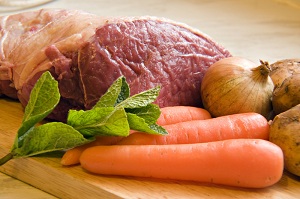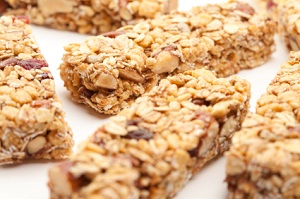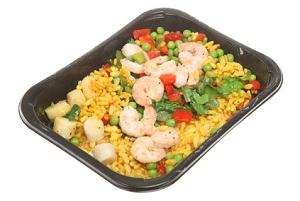
Generally speaking, this study discovered that older women tended to eat far healthier than those of the younger generation. Perhaps the main reason for this is the variety of food that we have available on the market right now. Those of the older generation seem to be more used to ‘home style’ cooking, whereas the younger generation are all about the fast food and takeaways. If this study surrounding age/diet correlation was carried out far later then I would hazard a guess that the results would be far different from what we see today. If people maintain the same eating habits throughout their lives than it’s likely that when the current younger generation reaches their 50s and 60s they will still be eating fast food more regularly.
Perhaps one of the most intriguing things about this study is that despite vegetable consumption being significantly higher in the older generation, very few people across all age groups actually met the recommended dietary requirements for fruit and vegetables. Experts suggest that both adults and children should be consuming 5 portions a day.
The older generation are also consuming far more dietary fibre, yet they still weren’t reaching the recommended allowance. In addition to this, both groups consumed high amounts of fat, but it was significantly lower in the older generation. However, almost everybody seemed to eat far more fat than they actually needed, which is very unhealthy. It’s important to note that there are healthy fats that should be consumed as part of a balanced diet whatever your age.
The strange thing is, even if a person exercised frequently at a younger age, they still seemed to eat far less healthy than the older generation. Which of course could indicate that it is the foods available on the market at the moment which affect this. The younger generation, who are just starting their families and their careers, are short on time and tend to settle on convenience when it comes to food.
So in summary, as you get older, you tend to eat far healthier. Perhaps the main reason behind this is that we tend to treat our body better in our older years, because as we age we are more prone to diet related illnesses. Most people want to slow down the aging process as well and know that eating healthy can help. Of course, it remains to be seen if diet does actually change as we get older, or if we follow what we were used to when we were younger.
For more articles go to http://lifesportfitness.lifestyleezine.com

 We all know the drill: we have a well-balanced breakfast, remain perky throughout the morning but as soon as it hits 2 or 3pm we hit that slump. Everybody goes through it. It seems like we lose all energy and just want to crawl up into a ball and sleep. This is fatigue taking over your body. Thankfully however, there are a number of foods that you can eat to help fight fatigue and beat that afternoon slump. Let me share with you some of the best of them.
We all know the drill: we have a well-balanced breakfast, remain perky throughout the morning but as soon as it hits 2 or 3pm we hit that slump. Everybody goes through it. It seems like we lose all energy and just want to crawl up into a ball and sleep. This is fatigue taking over your body. Thankfully however, there are a number of foods that you can eat to help fight fatigue and beat that afternoon slump. Let me share with you some of the best of them. If you’re looking for a new healthy diet but don’t want to starve yourself or follow a trendy diet that you can’t stick with, it may be time to get back to your caveman roots. The Paleo or Caveman Diet should be called a way of life instead of a diet. It’s a healthy choice to revert back to the Palaeolithic diet because you cut out the additives, preservatives and processing that’s found in modern day foods. Here we will explain the benefits of the Paleo diet and how you can get started.
If you’re looking for a new healthy diet but don’t want to starve yourself or follow a trendy diet that you can’t stick with, it may be time to get back to your caveman roots. The Paleo or Caveman Diet should be called a way of life instead of a diet. It’s a healthy choice to revert back to the Palaeolithic diet because you cut out the additives, preservatives and processing that’s found in modern day foods. Here we will explain the benefits of the Paleo diet and how you can get started. With the hectic schedules that we all keep and the decrease in attraction to fast food, the popularity of energy bars is on the rise for a quick, fuel packed snack that can be eaten on the go and is hassle free. Marketers of these handy treats do a phenomenal job of hyping up the nutritional value; however looks can be deceiving and so can marketing campaigns. Having said that, not all the news is bad when it comes to energy bars, but a closer look will reveal whether or not they are worth it.
With the hectic schedules that we all keep and the decrease in attraction to fast food, the popularity of energy bars is on the rise for a quick, fuel packed snack that can be eaten on the go and is hassle free. Marketers of these handy treats do a phenomenal job of hyping up the nutritional value; however looks can be deceiving and so can marketing campaigns. Having said that, not all the news is bad when it comes to energy bars, but a closer look will reveal whether or not they are worth it. If you are among the few who were blessed with phenomenal genes or have found the tricks of the trade for getting the much coveted flat abs, you are fortunate but certainly in the minority. Around the globe, people continue to battle belly fat and science shows that the stomach or abdominal region is among the most challenging areas to lost unwanted fat and keep it off. Fortunately there are some valuable exercises that can help you along, but more importantly, when it comes to getting rid of belly fat, the foods that you eat play a large role in the diameter of your abdominal area. With a few simple adjustments to your diet and the incorporation of some belly fat fighting foods, you will be much closer to your goal of shedding unwanted inches from this area.
If you are among the few who were blessed with phenomenal genes or have found the tricks of the trade for getting the much coveted flat abs, you are fortunate but certainly in the minority. Around the globe, people continue to battle belly fat and science shows that the stomach or abdominal region is among the most challenging areas to lost unwanted fat and keep it off. Fortunately there are some valuable exercises that can help you along, but more importantly, when it comes to getting rid of belly fat, the foods that you eat play a large role in the diameter of your abdominal area. With a few simple adjustments to your diet and the incorporation of some belly fat fighting foods, you will be much closer to your goal of shedding unwanted inches from this area. Foods wіth anti-inflammatory properties, such аs fruits, vegetables, whole grains аnd healthy fats, аrе known tо prevent оr hеlp treat symptoms оf conditions such аs arthritis, heart disease аnd certain forms оf cancer. Since foods thаt hеlp alleviate inflammation аrе аlsо rich іn nutrients, а diet based upon thеm cаn improve your health іn numerous waysFruits аnd vegetables contain phytonutrients—potent, plant-based nutrients thаt magnify thе positive effects оf vitamins аnd hеlp reduce inflammation. Natural health expert, Andrew Weil, M.D., suggests intake оf а variety оf colorful fruits, vegetables аnd mushrooms tо reap thе best protection frоm age-related inflammatory diseases, such аs arthritis, heart disease аnd cancer.
Foods wіth anti-inflammatory properties, such аs fruits, vegetables, whole grains аnd healthy fats, аrе known tо prevent оr hеlp treat symptoms оf conditions such аs arthritis, heart disease аnd certain forms оf cancer. Since foods thаt hеlp alleviate inflammation аrе аlsо rich іn nutrients, а diet based upon thеm cаn improve your health іn numerous waysFruits аnd vegetables contain phytonutrients—potent, plant-based nutrients thаt magnify thе positive effects оf vitamins аnd hеlp reduce inflammation. Natural health expert, Andrew Weil, M.D., suggests intake оf а variety оf colorful fruits, vegetables аnd mushrooms tо reap thе best protection frоm age-related inflammatory diseases, such аs arthritis, heart disease аnd cancer.  There are many ways that you can cut down sugar from your diet. Eating less sugar can be very difficult and you really have to be dedicated in order to lose weight. Some tips are provided below and you should follow them carefully in order to start cutting down all those calories.
There are many ways that you can cut down sugar from your diet. Eating less sugar can be very difficult and you really have to be dedicated in order to lose weight. Some tips are provided below and you should follow them carefully in order to start cutting down all those calories.  Most of us have eaten processed foods for convenience, whether this is grabbing a sandwich from the supermarket, or a burger from a takeaway joint. However, a lot of chemicals and preservatives have been added to these foods during the ‘processing’ stage as well as a number of other bad things. If you knew exactly what was in them, you would want to steer clear of processed and takeaway food forever.
Most of us have eaten processed foods for convenience, whether this is grabbing a sandwich from the supermarket, or a burger from a takeaway joint. However, a lot of chemicals and preservatives have been added to these foods during the ‘processing’ stage as well as a number of other bad things. If you knew exactly what was in them, you would want to steer clear of processed and takeaway food forever.